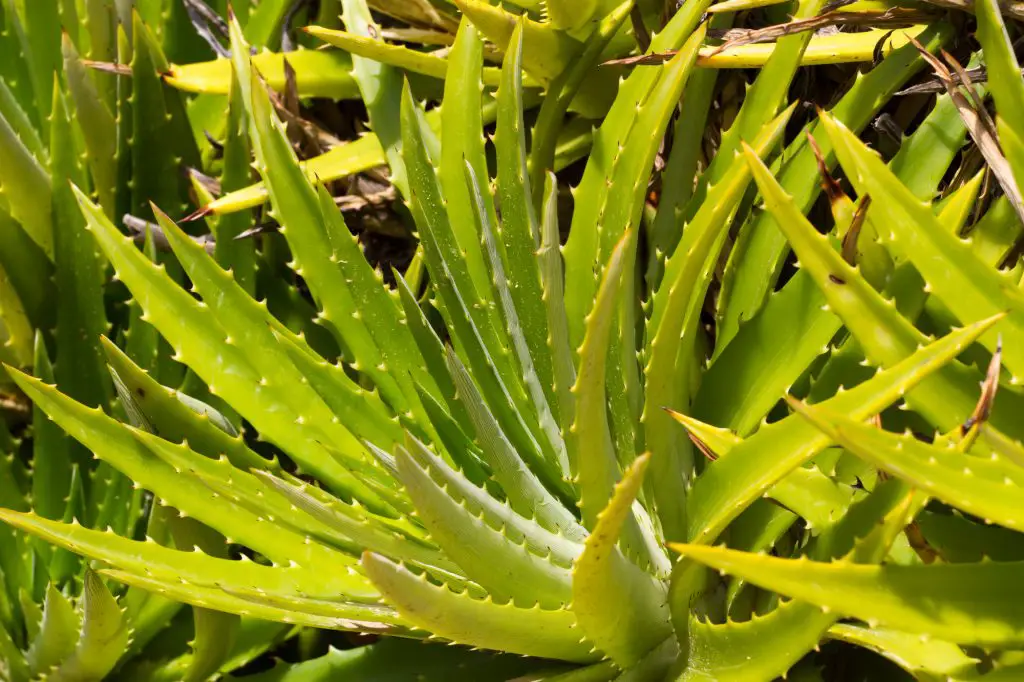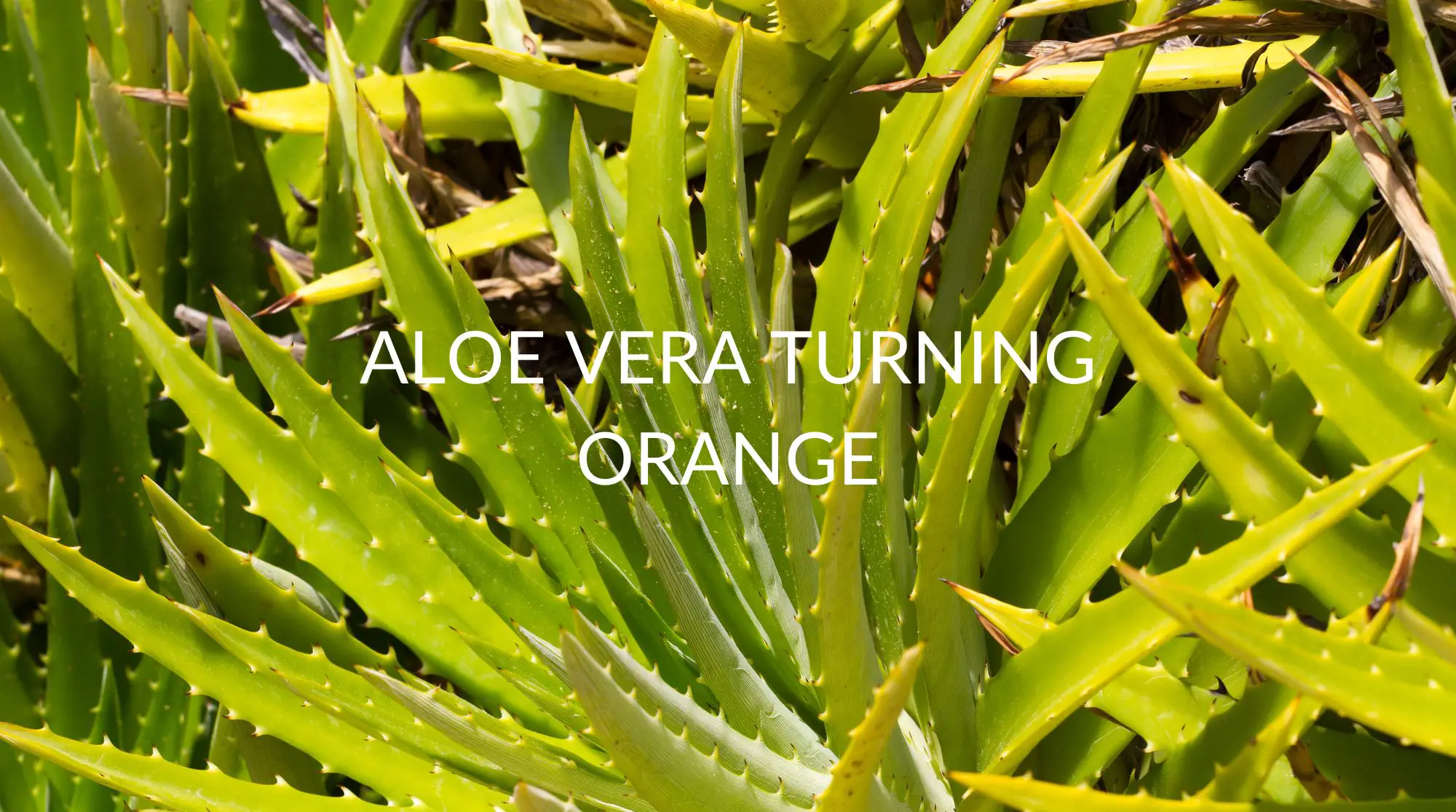If you grow Aloe Vera in your garden or in your house, you must have noticed one thing; the leaves of the plant sometimes turn orange because of seemingly inexplicable reasons. Aloe Vera’s leaves turn orange when they’re sunburnt, exposed to harsh and cold weather, under-watered, or over-watered. Leaving your plant in the sunlight for too long can cause an overdose of sunlight, and a shortage or surplus of water or moisture in the soil could lead to root loss or drought stress. In these cases, the leaves slowly fade in color from green to orange.
Read below for important information about the reasons why your Aloe Vera becomes distressed enough to fade in color and how you can cure your plant to restore its health and green color.
Why Is My Aloe Vera Turning Orange?
Too Much Exposure to Sunlight
If your Aloe Vera is turning green but is still turgid with no signs of mushiness or rotting, that means the amber color of the plant is caused by a surplus of sunlight. Plants need time to adapt to such a high exposure to sunlight. Getting sunburnt can make them dehydrated, and their leaves start fading from a healthy green to a mild yellow or orange.
Not Enough Hydration
Leaving your plant under-watered will make it under-hydrated and shrivel up, losing its color. This causes the soil to dry up, so the Aloe Vera now has less water to use for its nutrition. If left un-watered for a long time, the plant starts turning orange-brown, and the leaves start shrinking.
Too Much Hydration
If the plant is overwatered, the leaves will become mushy and change color from green to orange. Since Aloe Vera is a tropical plant, it doesn’t need a lot of water as it rots the roots. Overwatering overwhelms the plant and ruins the soil that its roots are situated in, causing them to root and affecting the leave color.
Overpotting and Waterlogging
According to Deep Green Permaculture, an educational website, overpotting your Aloe Vera can cause waterlogging, which has the same effects as that of overwatering. If the pot is too large, the plant’s roots will not be able to use up all the water, causing an overload of moisture. This causes the soil to stay wet for long periods of time, without proper drainage.
Environmental Distress
As per the National Gardening Association, if the weather conditions are changed abruptly, for example, putting a plant from shade to sunlight, it can cause the leaves to orange from the ends. Drought conditions and root loss also occur because of unfavorable weather conditions. Harsher cold weather can harm Aloe Vera’s health and cause the leaves to be orange.

How to Cure Aloe Vera Turning Orange?
Identify the Cause of the Color Change
To cure your plant, first, you need to identify the cause because of which the leaves are changing color from green to orange. There are tests to determine if the soil around your plant is waterlogged or under-watered. A sunburnt Aloe Vera exhibits different symptoms than that of an overwatered or environmentally distressed Aloe Vera.
Reduce Sunlight Exposure to Cure Sunburn
If your plant’s leaves are still sturdy with no signs of mushiness, chances are they’re turning brown because they’re getting too much sun. The solution to this would be to remove the plant from the sunny place and place it in the shade for a while. This recovers the plant’s yellowing and orange condition and restores its health.
Water Them Adequately to Avoid Dry Soil
Avoid under-watering your plant. Even though Aloe Vera is a plant that can withstand harsh conditions and survive even if it doesn’t get a lot of water, you should not take advantage of that and neglect your plant’s health. Water it sufficiently and with proper intervals to avoid the soil from becoming dry, causing your plant to shrivel up.
Stop Overwatering Your Plant
Test if the soil is becoming muddy due to too much water present in it, and change the soil to one with an adequate amount of water for the Aloe Vera to thrive in. Place the plant under a shade to avoid overwatering from rainfall. Monitor the moisture in the soil from time to time to avoid overwatering it.
Change Pots to Solve Overpotting
Although transplant stress can also cause your plant to fade in color, you should repot your plant to one that has a proper drainage system. Proper drainage of water will make sure the plant is getting as much water as it is going to use and the roots don’t become flooded. Make sure the drainage frequency is not too much to make the soil dry or too little to flood it.
Keep the Aloe Vera Away From Harsh Weather Conditions
Before doing this, we’d suggest giving the plant some time to adapt to the new weather conditions. If this doesn’t work, remove the plant from those conditions entirely. For example, place it under shade to avoid sunlight and rainfall. Move the plant indoors to keep it away from shocks caused by seasonal changes such as summer to winter.
Balance Out the Plant’s PH
Repotting the plant or changing its location can sometimes cause it to have difficulty adapting to the soil conditions. To solve this, balance out the plant’s pH by using phosphorus-rich fertilizers for the soil. Just make sure not to over-fertilize it for an overdose of nutrients, as that can damage the plant’s health too.
How Do I Get My Aloe Vera Plant Green Again?
Remove Burnt Leaves
The first thing to do to restore your plant and stop it from dying is to remove the burnt leaves (in case of sunburn). By removing the leaves, you’re making sure that the nutrition and water the plant gets is not wasted on the unsalvageable leaves and that the other leaves do not get affected by the presence of burnt ones. Don’t remove the leaves browning from the end as they can be salvaged.
Use Root Growth Stimulators
In case of root rot caused by extreme climatic conditions and waterlogging, make sure to solve the above conditions and use stimulators to restore the root’s health. Use seaweed extract as a root growth stimulator. Not only can seaweed extract help restore root health, but it can also reduce the stress caused to the Aloe Vera plant by harsh climates and extreme weather.
Adjust the Frequency of Watering
Usually, Aloe Vera plants do not require to be watered a lot; however, how much you should water the plants also depends on their location. If you keep your plant outside, water it every two weeks. If you keep it indoors, reduce the frequency of watering and water it every 3-4 weeks. To solve sunburn and under-watering, water the plant slightly more for a while to restore its health.
Properly Repot for a Change of Soil
Repot properly and make sure the pot has a drainage hole, monitor the water intake of the soil, and adjust accordingly, and you’ll see significant improvement. If the plant does not come out of the pot easily, break the pot. Don’t pull the plant out of the pot as it may damage the leaves and roots; instead, pull it out gently, steadily, and slowly while holding the pot upside down.
Moisture and pH Control
The moisture and pH of the soil need to be controlled for the plant to regain its healthy green color. Press an index finger a few inches or more down the soil. If the soil is too dry, your plant needs more water. If it’s too wet, your plant needs repotting or moisture control. Use fertilizers in reasonable quantities to balance out pH and witness the return to the green color of the leaves.
Monitor Temperature Fluctuations and Water Accordingly
If the temperature is too hot, water the plant more. If it is not, water it as you would normally. Also, keep in mind the temperature of the surroundings and change the Aloe Vera plant’s location and nutrition accordingly. Keep your plant indoors for a while until it stabilizes.
Keep an Eye Out for Change in Weather Conditions
Temperature fluctuations and seasonal changes should be accounted for and kept in mind to restore the health of your plant. Make a calendar of sorts and make sure you change the location of the plants during extremely rainy, cold, or snowy conditions. Considerations on your part will keep the plant out of harm’s way and restore it.
Recap
Even though Aloe Vera is a tough plant, harsh conditions can make it wither and die. Aloe Vera turns orange, brown, or amber due to a handful of reasons, some of them being exposure to the sun, over-watering, under-watering, overpotting, and environmental stress. These all combined can cause the leaves to turn orange from the tips and then turn the whole leaf orange.
To stop this color change and restore your plant health, you can monitor the soil pH, change the plant location, use fertilizers and stimulators, and adjust the watering frequency. By now, we hope you’ve found out all there is to know about why your Aloe Vera plant is turning orange and what you can do to fix it as the plant’s owner.


